While trying to stop an Israeli bulldozer from demolishing Palestinian homes in the Gaza Strip city of Rafah in March 2003, American peace activist Rachel Corrie was struck down by the machine, and its operators claimed that they never saw her.
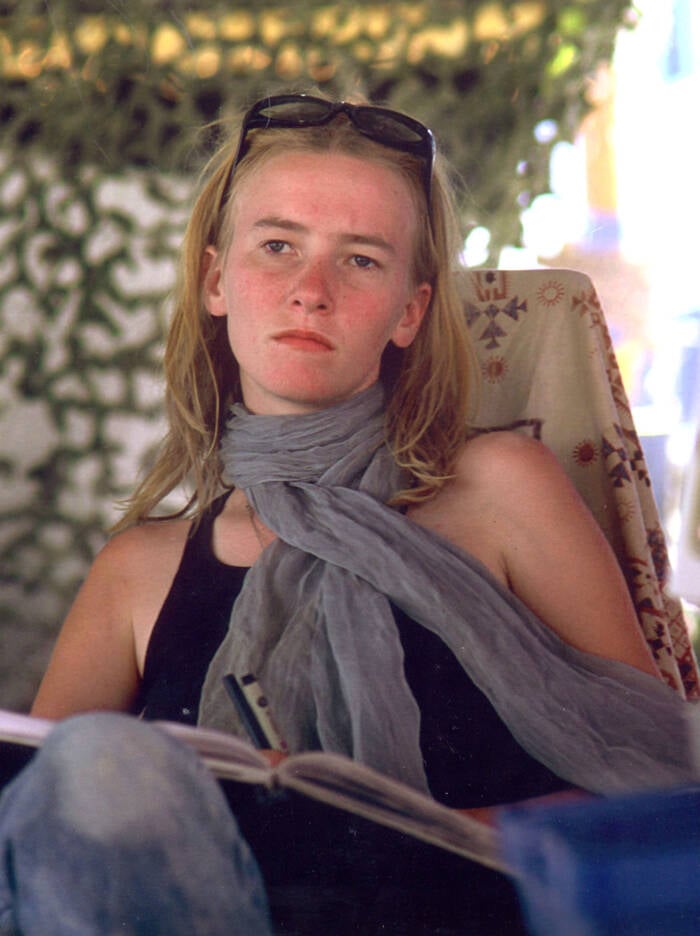
The Rachel Corrie Foundation for Peace and JusticeSince her death, Rachel Corrie has become a symbol of resistance in Gaza.
On a spring day in 2003, Rachel Corrie set out with a mission in mind. Clutching a bullhorn and wearing an orange jacket, she joined several other activists in the Gaza Strip to protest the Israeli demolition of Palestinian homes. It wasn’t the 23-year-old’s first experience acting as a human shield. But this time ended in tragedy.
As Corrie faced off with an armored bulldozer operated by the Israeli Defense Forces (IDF) in front of a home in Rafah, she expected that it would halt. But the bulldozer kept going. It ran her over — purportedly twice — as her fellow volunteers screamed for it to stop.
Rachel Corrie has since become a martyr in Gaza and beyond. However, the Israeli military ultimately claimed that the bulldozer operators had not seen her and maintained that her death was her own fault since she had not moved out of their path.
This is her story.
Rachel Corrie’s Journey From Washington State To The Gaza Strip
Born in April 1979 to parents Cindy and Craig Corrie in Olympia, Washington, Rachel Corrie had an average middle-class upbringing. She became aware of worldwide problems at a young age — and sought to change them.
At the age of 10, Corrie wrote and delivered a statement at the Washington state capitol about world hunger, according to NPR.
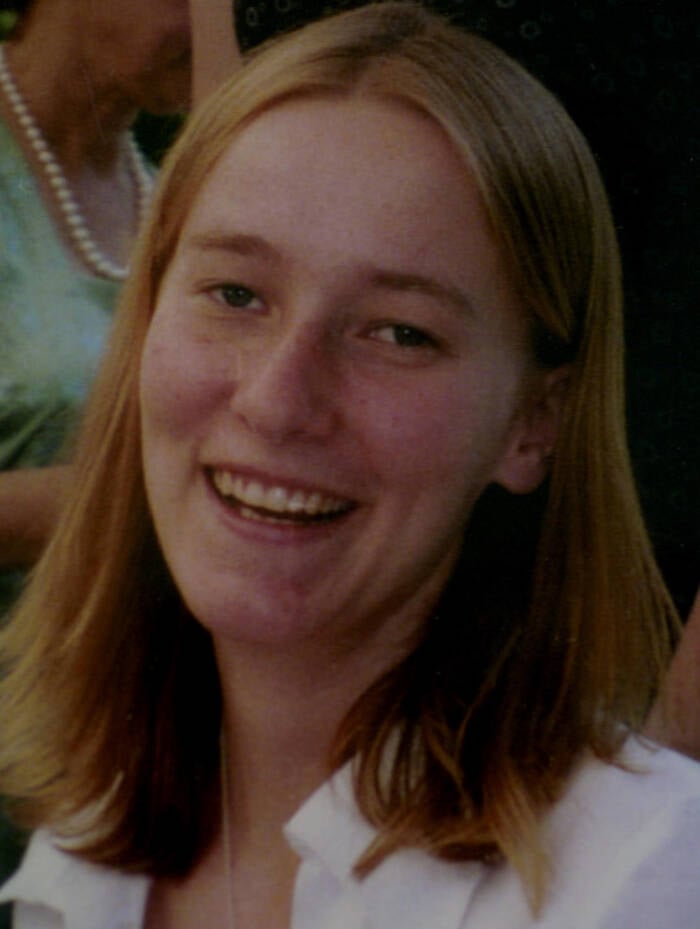
ZUMA Press, Inc. / Alamy Stock PhotoRachel Corrie circa 2002, a year before she was killed in Gaza.
“We have got to understand that the poor are all around us and we’re ignoring them,” she said. “We have got to understand that people in third-world countries think and care and smile and cry just like us. We have got to understand that they dream our dreams and we dream theirs. We have got to understand that they are us. We are them.”
Her interest in activism deepened at the Evergreen State College, where Corrie joined the Palestinian-led organization Olympians for Peace and Solidarity. The group’s goal was to challenge the Israeli army’s tactics in Gaza and the West Bank through nonviolence. And in her senior year, Corrie decided to travel to the Gaza Strip and participate in protests against Israeli forces in person with the International Solidarity Movement.
Staying with the Nasrallah family in Rafah, Corrie had a firsthand look at the struggles of Palestinians, many of whom were at risk of losing their homes to Israeli demolitions. (The Israeli government claimed that they needed to clear the area because Palestinian militants were hiding in structures to fire upon IDF troops.)
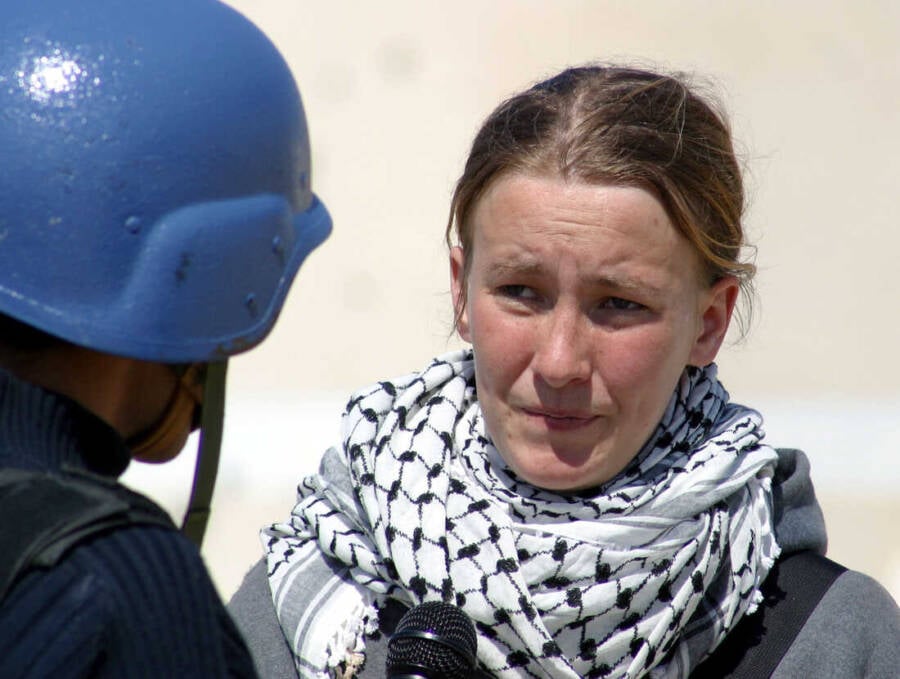
YouTubeRachel Corrie giving an interview just a few days before she was crushed by an Israeli bulldozer.
Rachel Corrie wrote to her parents: “It’s hard to hold in your mind what’s happening here — living lives that no child should have to live.”
In an interview with the Middle East Broadcasting network in March 2003, just two days before she was killed, Corrie reiterated what she’d told her parents.
“In the time I’ve been here, children have been shot and killed,” she said. “I feel like what I’m witnessing here is a very systematic destruction of people’s ability to survive. And that is incredibly horrifying.”
But her next protest would take a terrible, violent turn.
‘He Reversed The Bulldozer Back Over Her Again’
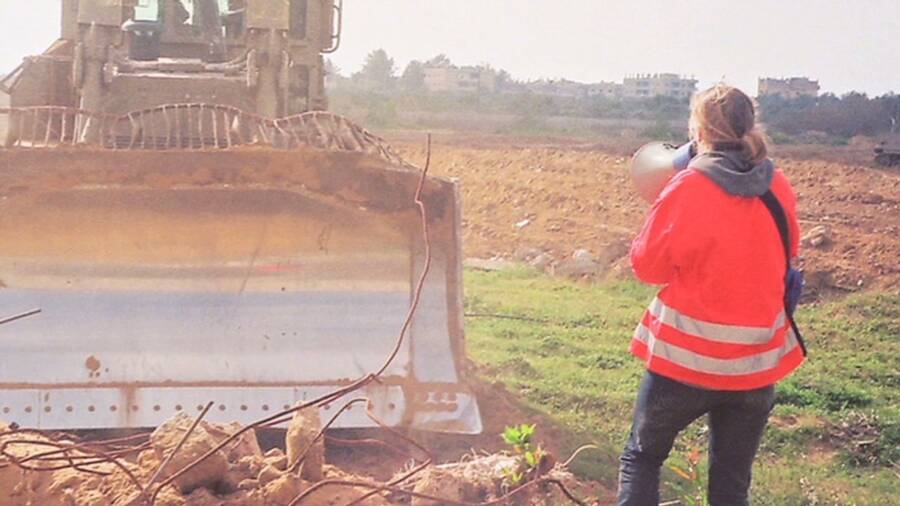
Joe Carr/Wikimedia CommonsRachel Corrie and her fellow activists acted as “human shields” between Israeli bulldozers and Palestinian homes. This photo was purportedly taken earlier in the day on March 16, before the incident in which she was killed.
On March 16, 2003, Rachel Corrie and several other activists prepared to act as “human shields” in front of homes at risk of demolition in Rafah. Their task was especially personal: That day, they would be protecting the Nasrallah home, where Corrie had been staying.
When the bulldozers arrived, Corrie took up position in front of the Nasrallahs’ house. Standing on a mound of earth with her bullhorn, Corrie fully expected the bulldozer to stop. Instead, it plowed forward.
Her fellow activists insist that Corrie was clearly visible to the bulldozer but that she slid down as the dirt and debris began to move beneath her feet.
“As the ground continued to move Rachel went down on her knees,” one activist, Greg Schnabel, recalled, according to the Independent. “The bulldozer continued to move forward. Rachel began to become buried beneath the dirt. Still it did not stop.”
Another activist, Tom Dale, claimed, “The bulldozer went towards her very slowly. She was fully in clear view, straight in front of them… All the activists there were screaming, running towards the bulldozer, trying to get them to stop. But they just kept on going.”
And another witness, Richard Purssell, said: “The driver didn’t slow down; he just ran over her. Then he reversed the bulldozer back over her again.”
Corrie’s fellow activists surged forward to help her. But by the time they reached her, it was too late to do anything.
“She was obviously in terrible condition,” Schnabel said. “Her upper lip had been split open and was bleeding. She was breathing but she was losing consciousness rapidly. Within a minute she was no longer able to give us her name or speak. We continued to talk to her, encouraging her, breathing with her, and telling her we loved her.”
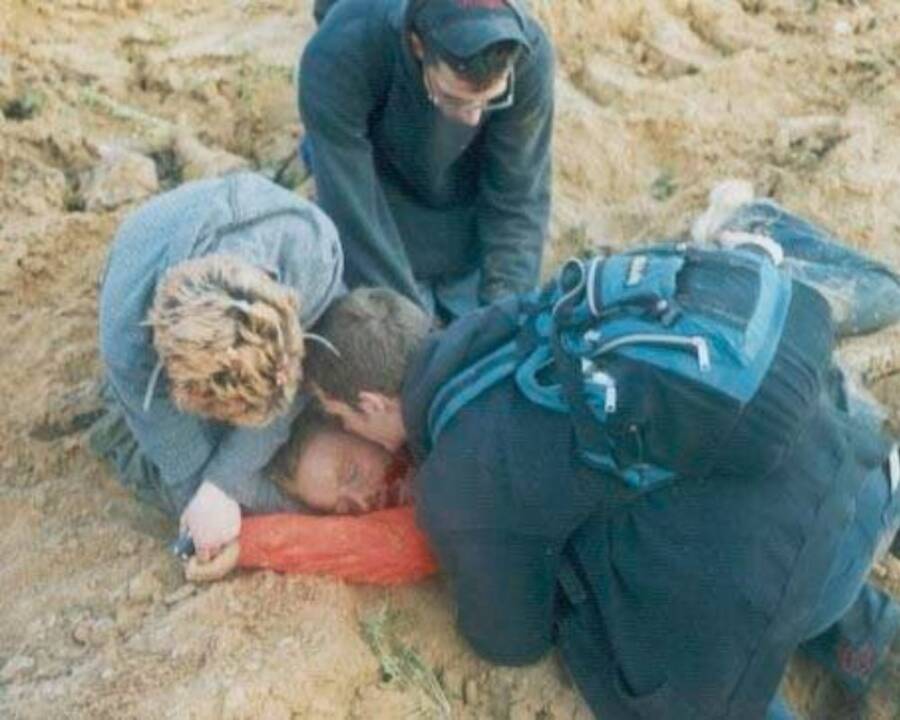
Joe Carr/Wikimedia CommonsAfter Rachel Corrie was crushed, her fellow activists tried to help her — but it was too late.
Corrie died soon afterward. Her death was quickly overshadowed by the U.S. invasion of Iraq, which took place a few days later, on March 20, 2003.
That said, plenty of people never forgot Rachel Corrie.
How Rachel Corrie Became A Martyr In Gaza And Beyond
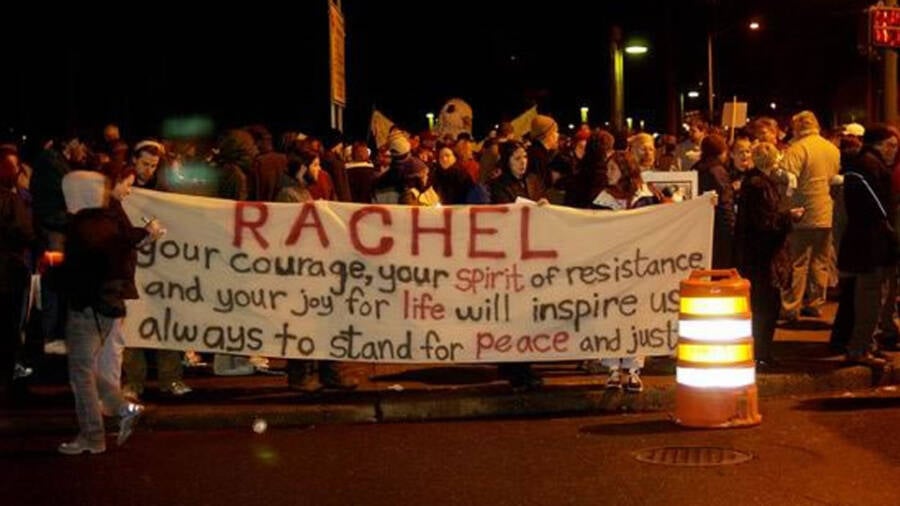
MyRedDice/Wikimedia CommonsA march at the Evergreen State College in the aftermath of Rachel Corrie’s death.
In the immediate aftermath of Rachel Corrie’s death, her family and her fellow activists blamed the IDF. However, Israel claimed that Corrie’s death had been an accident. An April 2003 IDF investigation determined that the bulldozer operators had not seen Corrie. Israeli officials also claimed that Corrie had not been crushed by the bulldozer but rather by “debris.”
“Contrary to allegations, Ms. Corrie was not run over by a bulldozer, but sustained injuries caused by earth and debris which fell on her during bulldozer operation,” the investigation stated. “At the time of the incident Ms. Corrie was standing behind an earth mound and therefore obscured from [the] bulldozer crew’s view.”
What’s more, Israeli officials said the bulldozer wasn’t destroying additional homes that day but rather clearing debris and vegetation from previous demolitions.
However, that wasn’t good enough for Corrie’s parents. In 2005, they sued Caterpillar Inc. on the grounds that the company knew its equipment would be used “illegally.” The Corrie family wanted to charge Caterpillar with war crimes, but the case was ultimately dismissed.
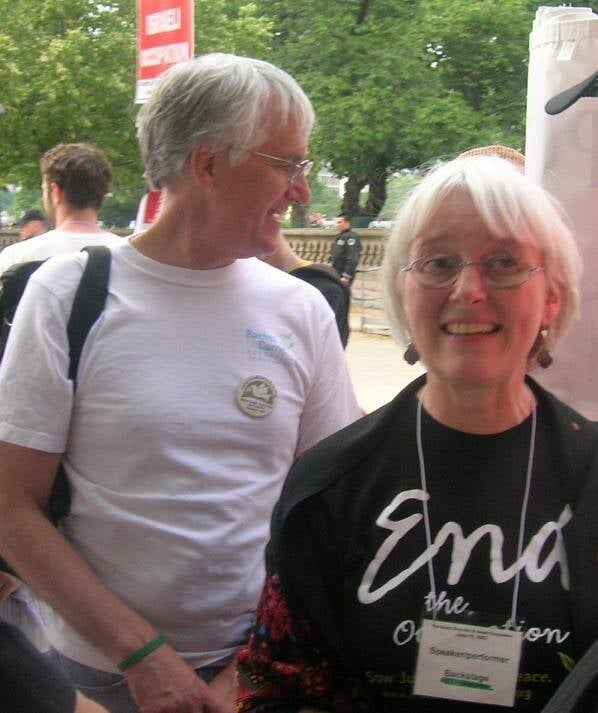
Public DomainCraig and Cindy Corrie at a “Stop the Occupation” rally in 2007.
In 2010, the Corrie family also sued the IDF and Israel’s defense ministry for $1. However, a judge ruled against them, finding that Corrie had “consciously put herself in danger” by not moving out of the way of the bulldozer.
The Corrie family appealed, but Israel’s Supreme Court dismissed the case in 2015 on the grounds that international law didn’t apply to Gaza.
Though legal action has failed, Rachel Corrie has not been forgotten. She’s seen as a martyr and a symbol of resistance in Gaza today and is annually honored by many Arab newspapers.
Her parents are aware that Rachel Corrie’s death has received more attention than the thousands of Palestinians who have been killed, many by Israeli forces. To honor her memory, promote peace, and publicize the suffering of many Palestinians, they launched the Rachel Corrie Foundation for Peace and Justice in 2003.
“Rachel was filled with a love and sense of duty to our fellow man, wherever they lived,” said Corrie’s father, as reported by the BBC in 2012, “and she gave her life trying to protect those that could not protect themselves.”
After reading about the life and death of 23-year-old activist Rachel Corrie, discover the story of the Lebanese Civil War through these 33 tragic photos. Or, learn about Ron Kovic, the Vietnam War hero whose anti-war activism inspired the Tom Cruise film Born on the Fourth of July.





